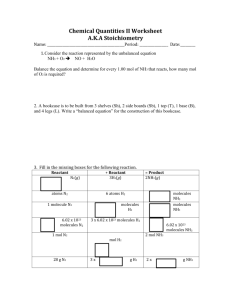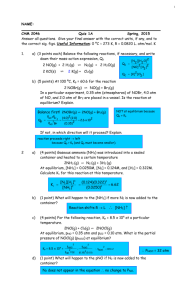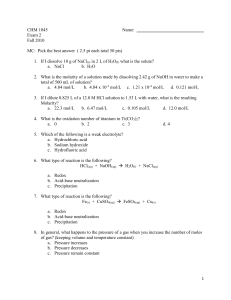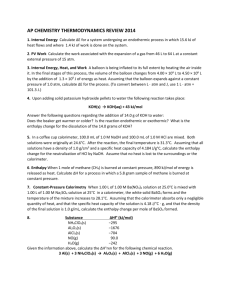Chemistry Mock Multiple Choice Exam A
advertisement
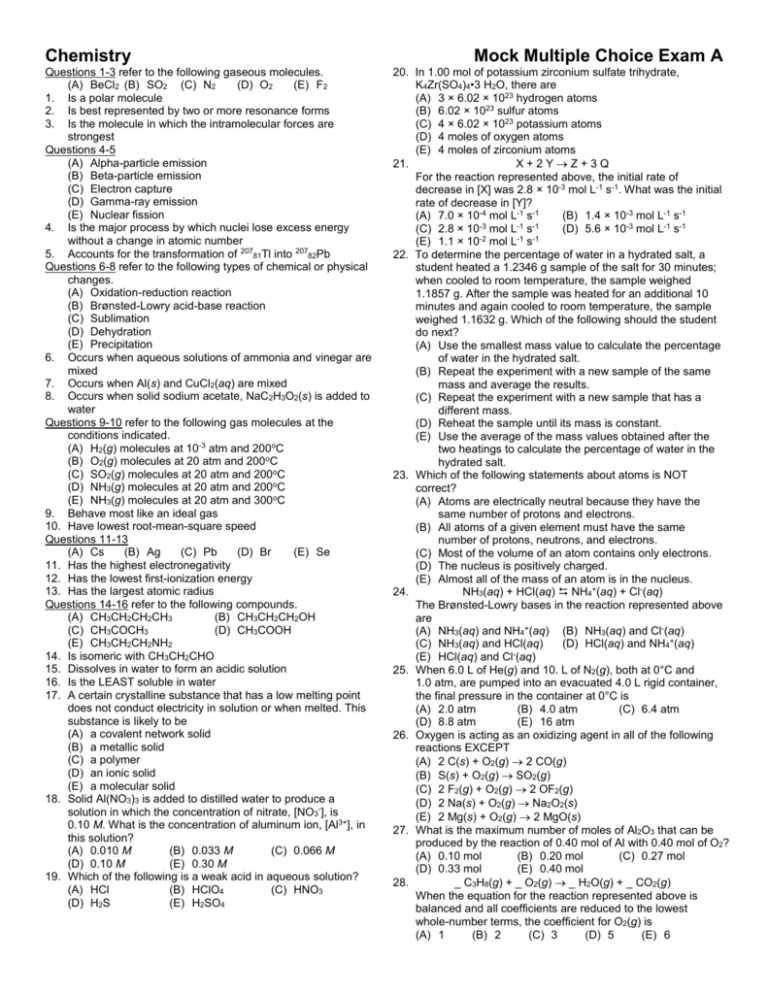
Chemistry Questions 1-3 refer to the following gaseous molecules. (A) BeCl2 (B) SO2 (C) N2 (D) O2 (E) F2 1. Is a polar molecule 2. Is best represented by two or more resonance forms 3. Is the molecule in which the intramolecular forces are strongest Questions 4-5 (A) Alpha-particle emission (B) Beta-particle emission (C) Electron capture (D) Gamma-ray emission (E) Nuclear fission 4. Is the major process by which nuclei lose excess energy without a change in atomic number 5. Accounts for the transformation of 20781Tl into 20782Pb Questions 6-8 refer to the following types of chemical or physical changes. (A) Oxidation-reduction reaction (B) Brønsted-Lowry acid-base reaction (C) Sublimation (D) Dehydration (E) Precipitation 6. Occurs when aqueous solutions of ammonia and vinegar are mixed 7. Occurs when Al(s) and CuCl2(aq) are mixed 8. Occurs when solid sodium acetate, NaC2H3O2(s) is added to water Questions 9-10 refer to the following gas molecules at the conditions indicated. (A) H2(g) molecules at 10-3 atm and 200oC (B) O2(g) molecules at 20 atm and 200oC (C) SO2(g) molecules at 20 atm and 200oC (D) NH3(g) molecules at 20 atm and 200oC (E) NH3(g) molecules at 20 atm and 300oC 9. Behave most like an ideal gas 10. Have lowest root-mean-square speed Questions 11-13 (A) Cs (B) Ag (C) Pb (D) Br (E) Se 11. Has the highest electronegativity 12. Has the lowest first-ionization energy 13. Has the largest atomic radius Questions 14-16 refer to the following compounds. (A) CH3CH2CH2CH3 (B) CH3CH2CH2OH (C) CH3COCH3 (D) CH3COOH (E) CH3CH2CH2NH2 14. Is isomeric with CH3CH2CHO 15. Dissolves in water to form an acidic solution 16. Is the LEAST soluble in water 17. A certain crystalline substance that has a low melting point does not conduct electricity in solution or when melted. This substance is likely to be (A) a covalent network solid (B) a metallic solid (C) a polymer (D) an ionic solid (E) a molecular solid 18. Solid Al(NO3)3 is added to distilled water to produce a solution in which the concentration of nitrate, [NO3-], is 0.10 M. What is the concentration of aluminum ion, [Al3+], in this solution? (A) 0.010 M (B) 0.033 M (C) 0.066 M (D) 0.10 M (E) 0.30 M 19. Which of the following is a weak acid in aqueous solution? (A) HCl (B) HClO4 (C) HNO3 (D) H2S (E) H2SO4 Mock Multiple Choice Exam A 20. In 1.00 mol of potassium zirconium sulfate trihydrate, K4Zr(SO4)4•3 H2O, there are (A) 3 × 6.02 × 1023 hydrogen atoms (B) 6.02 × 1023 sulfur atoms (C) 4 × 6.02 × 1023 potassium atoms (D) 4 moles of oxygen atoms (E) 4 moles of zirconium atoms 21. X+2YZ+3Q For the reaction represented above, the initial rate of decrease in [X] was 2.8 × 10-3 mol L-1 s-1. What was the initial rate of decrease in [Y]? (A) 7.0 × 10-4 mol L-1 s-1 (B) 1.4 × 10-3 mol L-1 s-1 -3 -1 -1 (C) 2.8 × 10 mol L s (D) 5.6 × 10-3 mol L-1 s-1 (E) 1.1 × 10-2 mol L-1 s-1 22. To determine the percentage of water in a hydrated salt, a student heated a 1.2346 g sample of the salt for 30 minutes; when cooled to room temperature, the sample weighed 1.1857 g. After the sample was heated for an additional 10 minutes and again cooled to room temperature, the sample weighed 1.1632 g. Which of the following should the student do next? (A) Use the smallest mass value to calculate the percentage of water in the hydrated salt. (B) Repeat the experiment with a new sample of the same mass and average the results. (C) Repeat the experiment with a new sample that has a different mass. (D) Reheat the sample until its mass is constant. (E) Use the average of the mass values obtained after the two heatings to calculate the percentage of water in the hydrated salt. 23. Which of the following statements about atoms is NOT correct? (A) Atoms are electrically neutral because they have the same number of protons and electrons. (B) All atoms of a given element must have the same number of protons, neutrons, and electrons. (C) Most of the volume of an atom contains only electrons. (D) The nucleus is positively charged. (E) Almost all of the mass of an atom is in the nucleus. 24. NH3(aq) + HCl(aq) NH4+(aq) + Cl-(aq) The Brønsted-Lowry bases in the reaction represented above are (A) NH3(aq) and NH4+(aq) (B) NH3(aq) and Cl-(aq) (C) NH3(aq) and HCl(aq) (D) HCl(aq) and NH4+(aq) (E) HCl(aq) and Cl-(aq) 25. When 6.0 L of He(g) and 10. L of N2(g), both at 0°C and 1.0 atm, are pumped into an evacuated 4.0 L rigid container, the final pressure in the container at 0°C is (A) 2.0 atm (B) 4.0 atm (C) 6.4 atm (D) 8.8 atm (E) 16 atm 26. Oxygen is acting as an oxidizing agent in all of the following reactions EXCEPT (A) 2 C(s) + O2(g) 2 CO(g) (B) S(s) + O2(g) SO2(g) (C) 2 F2(g) + O2(g) 2 OF2(g) (D) 2 Na(s) + O2(g) Na2O2(s) (E) 2 Mg(s) + O2(g) 2 MgO(s) 27. What is the maximum number of moles of Al2O3 that can be produced by the reaction of 0.40 mol of Al with 0.40 mol of O2? (A) 0.10 mol (B) 0.20 mol (C) 0.27 mol (D) 0.33 mol (E) 0.40 mol 28. _ C3H8(g) + _ O2(g) _ H2O(g) + _ CO2(g) When the equation for the reaction represented above is balanced and all coefficients are reduced to the lowest whole-number terms, the coefficient for O2(g) is (A) 1 (B) 2 (C) 3 (D) 5 (E) 6 29. Shown below is the phase diagram of a pure substance. The substance under the conditions corresponding to point X on the diagram is cooled to 40oC while the pressure remains constant. 30. 31. 32. 33. 34. 35. 36. 37. As the substance cools, the phase of the substance changes from (A) gas to liquid to solid (B) gas to solid to liquid (C) solid to liquid to gas (D) liquid to solid to gas (E) liquid to gas to solid A 0.1 M solution of which of the following is colorless? (A) MgCl2 (B) Ni(NO3)2 (C) Na2CrO4 (D) KMnO4 (E) CuSO4 Under which of the following conditions can an endothermic reaction be thermodynamically favorable? (A) ΔG is positive (B) ΔS is negative (C) TΔS > ΔH (D) TΔS = 0 (E) There are no conditions under which an endothermic reaction can be thermodynamically favorable. The vapor pressure of pure water at 25oC is 24.0 mm Hg. What is the expected vapor pressure at 25oC of an ideal solution of a nonvolatile nonelectrolyte in which the mole fraction of water is 0.900? (A) 1.48 mm Hg (B) 2.40 mm Hg (C) 21.6 mm Hg (D) 24.0 mm Hg (E) 26.7 mm Hg Which of the following salts is LEAST soluble in water? (A) NiS (B) MgCl2 (C) K2CrO4 (D) Al2(SO4)3 (E) Pb(NO3)2 Which of the following is the best piece of laboratory glassware for preparing 500.0 mL of an aqueous solution of a solid? (A) Volumetric flask (B) Erlenmeyer flask (C) Test tube (D) Graduated beaker (E) Graduated cylinder When heated, metallic carbonates generally produce (A) metallic peroxide + CO (B) metal + CO + O2 (C) metallic hydroxide + CO2 (D) metallic oxalate + O2 (E) metallic oxide + CO2 Fe3+(aq) + SCN-(aq) Fe(SCN)2+(aq) For the reaction represented above, the value of the equilibrium constant, Keq, is 240 at 25oC. From this information, correct deductions about the reaction at 25oC include which of the following? I. The reaction is quite rapid. II. The product is favored over the reactants at equilibrium. III. The reaction is endothermic. (A) I only (B) II only (C) I and II only (D) II and III only (E) I, II, and III The volume of water that must be added in order to dilute 40 mL of 9.0 M HCl to a concentration of 6.0 M is closest to (A) 10 mL (B) 20 mL (C) 30 mL (D) 40 mL (E) 60 mL Questions 38-39 refer to the experiment described below. H2 gas and N2 gas were placed in a rigid vessel and allowed to reach equilibrium in the presence of a catalyst according to the following equation. 3 H2(g) + N2(g) 2 NH3(g) ΔHo = -92 kJ/molrxn The diagram below shows how the concentrations of H2, N2, and NH3 in this system changed over time. 38. Which of the following was true for the system between time t1 and time t2? (A) The concentration of N2 decreased. (B) The temperature of the system decreased. (C) The number of effective collisions between H2 and N2 was zero. (D) The rates of the forward and reverse reactions were equal. (E) The rate of formation of NH3 molecules was equal to the rate of disappearance of H2 molecules. 39. More NH3 gas is added to the system at time t2 while the temperature is held constant. Which of the following will most likely occur? (A) The value of the equilibrium constant will increase. (B) The value of the equilibrium constant will decrease. (C) The total pressure in the container will decrease. (D) The amount of N2 will increase. (E) The amount of H2 will decrease. 40. Which of the following statements best explains why an increase in temperature of 5-10 Celsius degrees can substantially increase the rate of a chemical reaction? (A) The activation energy for the reaction is lowered. (B) The number of effective collisions between reactant particles is increased. (C) The rate of the reverse reaction is increased. (D) H for the reaction is lowered. (E) G for the reaction becomes more positive. 41. 2 KClO3(s) 2 KCl(s) + 3 O2(g) What is the percentage yield of O2 if 12.3 g of KClO3 (MM 123 g) is decomposed to produce 3.2 g of O2 (MM 32 g) according to the equation above? (A) 100% (B) 67% (C) 50% (D) 33% (E) 10% 42. When a strong acid is titrated with a strong base using phenolphthalein as an indicator, the color changes abruptly at the endpoint of the titration and can be switched back and forth by the addition of only one drop of acid or base. The reason for the abruptness of this color change is that (A) a large change in pH occurs near the endpoint of the titration (B) a buffer solution exists at the endpoint of the titration (C) phenolphthalein is a strong proton donor (D) the pH of water is very resistant to change (E) phenolphthalein is much more sensitive to the pH of a solution than most other indicators 43. A 1 mol sample of zinc can reduce the greatest number of moles of which of the following ions? (A) Al3+ (B) Pb2+ (C) Ag+ (D) Cl(E) N344. At 298 K and 1 atm, bromine is a liquid with a high vapor pressure, whereas chlorine is a gas. This provides evidence that, under these conditions, the (A) forces among Br2 molecules are greater than those among Cl2 molecules (B) forces among Br2 molecules are weaker than the Br-Br bond (C) forces among Cl2 molecules are stronger than the Cl-Cl bond (D) Br-Br bond is stronger than the Cl-Cl bond (E) Br-Br bond is weaker than the Cl-Cl bond 45. The value of Ksp for PbCl2 is 1.6 x 10-5. What is the lowest concentration of Cl−(aq) that would be needed to begin precipitation of PbCl2(s) in 0.010 M Pb(NO3)2? (A) 1.6 x 10-7 M (B) 4.0 x 10-4 M (C) 1.6 x 10-3 M (D) 2.6 x 10-3 M (E) 4.0 x 10-2 M 46. Which of the following aqueous solutions has the lowest freezing point? (A) 0.2 m NaCl (B) 0.2 m CaCl2 (C) 0.2 m H2SO4 (D) 0.2 m NH3 (E) 0.2 m Al(NO3)3 47. Step 1: NO(g) + O3(g) NO2(g) + O2(g) Step 2: NO2(g) + O(g) NO(g) + O2(g) A reaction mechanism for the destruction of ozone, O3(g), is represented above. In the overall reaction, NO(g) is best described as (A) an inhibitor (B) a catalyst (C) a reactant (D) an intermediate (E) a product 48. When a buret is rinsed before a titration, which of the techniques below is the best procedure? (A) Rinse the buret one time with some of the titrant solution. (B) Rinse the buret one time with some of the titrant solution and then dry the buret in an oven. (C) Rinse the buret two times: once with some of the titrant solution, then once with distilled water. (D) Rinse the buret two times: each time with some of the titrant solution. (E) Rinse the buret two times: each time with distilled water. 49. Sr2+(aq) + F-(aq) SrF+(aq) o At 25 C, the equilibrium constant for the reaction represented above has a value of 1.3. At 50oC, the value of the equilibrium constant is less than 1.3. Based on this information, which of the following must be correct? (A) The reaction rate decreases as the temperature is increased. (B) The reaction is thermodynamically favorable only at temperatures above 25oC. (C) At 25oC, ΔGo for the reaction is positive. (D) At 25oC, ΔSo for the reaction is positive. (E) At 25oC, ΔHo for the reaction is negative. 50. Ni2+(aq) + 6 NH3(aq) [Ni(NH3)6]2+(aq) The reaction represented above is best classified as (A) a Lewis acid-base reaction (B) a Brønsted-Lowry acid-base reaction (C) an Arrhenius acid-base reaction (D) an oxidation-reduction reaction (E) a precipitation reaction 51. 4 NH3(g) + 3 O2(g) 2 N2(g) + 6 H2O(g) If the standard molar heats of formation of ammonia, NH3(g), and gaseous water, H2O(g), are -46 kJ/mol and -242 kJ/mol, respectively, what is the value of Ho298 for the reaction represented above? (A) -190 kJ/molrxn (B) -290 kJ/molrxn (C) -580 kJ/molrxn (D) -1,270 kJ/molrxn (E) -1,640 kJ/molrxn 52. 53. 54. 55. 56. 57. 58. 59. 60. 61. 62. Cu2+(aq) + 2 e- Cu(s) Eo = 0.34 V Cr3+(aq) + e- Cr2+(aq) Eo = -0.41 V According to the half-reactions represented above, which of the following occurs in aqueous solutions under standard conditions? (A) Cu2+(aq) + Cr3+(aq) Cu(s) + Cr2+(aq) (B) Cu2+(aq) + 2 Cr2+(aq) Cu(s) + 2 Cr3+(aq) (C) Cu(s) + 2 Cr3+(aq) Cu2+(aq) + 2 Cr2+(aq) (D) Cu(s) + Cr3+(aq) Cu2+(aq) + Cr2+(aq) (E) 2 Cu2+(aq) + Cr3+(aq) 2 Cu(s) + Cr2+(aq) _ Zn(s) + _ H+ + _ NO3- → _ Zn2+ + _ NH4+ + _ H2O(l) When the equation above is balanced and all coefficients are reduced to lowest whole number terms, the coefficient for Zn(s) is (A) 2 (B) 4 (C) 6 (D) 10 (E) 14 When a magnesium wire is dipped into a solution of lead(II) nitrate, a black deposit forms on the wire. Which of the following can be concluded from this observation? (A) The standard reduction potential, Eo, for Pb2+(aq) is greater than that for Mg2+(aq). (B) Mg(s) is less easily oxidized than Pb(s). (C) An external source of potential must have been supplied. (D) The magnesium wire will be the cathode of a Mg/Pb cell. (E) Pb(s) can spontaneously displace Mg2+(aq) from solution. Which of the molecules represented below contains carbon with sp2 hybridization? (A) CH4 (B) CH2Cl2 (C) C2H6 (D) C2H2Cl2 (E) C2H4Cl2 A chemical supply company sells a concentrated solution of aqueous H2SO4 (MM 98 g) that is 50. percent H2SO4 by mass. At 25°C, the density of the solution is 1.4 g mL−1. What is the molarity of the H2SO4 solution at 25°C? (A) 1.8 M (B) 3.6 M (C) 5.1 M (D) 7.1 M (E) 14 M A reaction produces a colorless gas, which is collected by water displacement. A glowing splint inserted into a bottle full of the gas is extinguished. The gas could be (A) N2 (B) NO2 (C) O2 (D) Br2 (E) Cl2 A solution of methanol, CH3OH , in water is prepared by mixing together 128 g of methanol and 108 g of water. The mole fraction of methanol in the solution is closest to (A) 0.80 (B) 0.60 (C) 0.50 (D) 0.40 (E) 0.20 A sample of a compound contains 3.21 g of sulfur and 11.4 g of fluorine. Which of the following represents the empirical formula of the compound? (A) SF2 (B) SF3 (C) SF4 (D) SF5 (E) SF6 Of the following, the best explanation for the fact that most gases are easily compressed is that the molecules in a gas (A) are in constant motion (B) are relatively far apart (C) have relatively small masses (D) have a real, nonzero volume (E) move slower as temperature decreases Given that the density of Hg(l) at 0°C is about 14 g mL-1, which of the following is closest to the volume of one mole of Hg(l ) at this temperature? (A) 0.070 mL (B) 0.14 mL (C) 1.4 mL (D) 14 mL (E) 28 mL Addition of sulfurous acid (a weak acid) to barium hydroxide (a strong base) results in the formation of a precipitate. The net ionic equation for this reaction is (A) 2 H+(aq) + 2 OH-(aq) 2 H2O(l) (B) H2SO3(aq) + Ba2+ + 2 OH- BaSO3(s) + 2 H2O(l) (C) 2 H+ + SO32- + Ba2+ + 2 OH- BaSO3(s) + 2 H2O(l) (D) H2SO3(aq) + Ba2+ + 2 OH- Ba2+ + SO32- + 2 H2O(l) (E) H2SO3(aq) + Ba(OH)2(aq) BaSO3(s) + 2 H2O(l ) 63. A sample of an unknown gas from a cylinder is collected over water in the apparatus shown below. After all the gas sample has been collected, the water levels inside and outside the gas collection tube are made the same. Measurements that must be made to calculate the molar mass of the gas include all of the following EXCEPT (A) atmospheric pressure (B) temperature of the water (C) volume of gas in the gas-collection tube (D) initial and final mass of the gas cylinder (E) mass of the water in the apparatus 64. ½H2(g) + ½I2(s) HI(g) ΔH = 26 kJ/molrxn ½H2(g) + ½I2(g) HI(g) ΔH = -5.0 kJ/molrxn Based on the information above, what is the enthalpy change for the sublimation of iodine, represented below? I2(s) → I2(g) (A) 15 kJ/molrxn (B) 21 kJ/molrxn (C) 31 kJ/molrxn (D) 42 kJ/molrxn (E) 62 kJ/molrxn 65. Which of the following graphs correctly shows the relationship between potential energy and internuclear separation for two hydrogen atoms? (A) (B) 68. The graph below shows the titration curve that resulted when a sample of 0.1 M monoprotic acid was titrated with a solution of NaOH. 69. 70. 71. 72. 73. (C) (D) 74. (E) 66. Which of the following compounds is LEAST likely to exist? (A) PCl5 (B) PBr3 (C) NF3 (D) NI5 (E) SbF5 67. When a student adds a sodium salt to an aqueous solution containing the five cations Ag+(aq), Hg22+(aq), Cu2+(aq), Mn2+(aq), and Ba2+(aq), no precipitate forms. Which of the following could be the anion in the sodium salt? (A) Cl-(aq) (B) CO32-(aq) (C) CrO42-(aq) (D) NO3-(aq) (E) SO42-(aq) 75. Based on the graph, the pKa of the acid is closest to (A) 3.0 (B) 4.0 (C) 6.0 (D) 8.0 (E) 12.0 The rate law for the reaction of nitrogen dioxide and chlorine is found to be rate = k [NO2]2[Cl2]. By what factor does the rate of the reaction change when the concentrations of both NO2 and Cl2 are doubled? (A) 2 (B) 3 (C) 4 (D) 6 (E) 8 What is the molarity of I-(aq) in a solution that contains 34 g of SrI2 (MM 341 g) in 1.0 L of the solution? (A) 0.034 M (B) 0.068 M (C) 0.10 M (D) 0.20 M (E) 0.68 M Which of the following compounds contains both ionic and covalent bonds? (A) SO3 (B) C2H5OH (C) MgF2 (D) H2S (E) NH4Cl Some pollutant gases in the atmosphere act as contributors to the formation of acid rain, a serious environmental problem. An example of such a gas is (A) N2 (B) O2 (C) H2O (D) NO2 (E) CH4 2 S(s) + 2 O2(g) 2 SO2(g) K1 = 2 x 10105 2 SO2(g) + O2(g) 2 SO3(g) K2 = 7 x 1024 Given the value of the equilibrium constants K1 and K2 for the reactions represented above, what is the value of the equilibrium constant, K3 , for the following reaction? 2 S(s) + 3 O2(g) 2 SO3(g) K3 = ? (A) 1 x 10130 (B) 3 x 1080 (C) 1 x 1065 (D) 2 x 1040 (E) 7 x 1024 Which of the following molecules is nonpolar but has polar covalent bonds? (A) N2 (B) H2O2 (C) H2O (D) CCl4 (E) CH2Cl2 A 0.10 M solution of which of the following salts is most basic? (A) LiNO3 (B) Na2SO4 (C) CaCl2 (D) Al(NO3)3 (E) K2CO3
